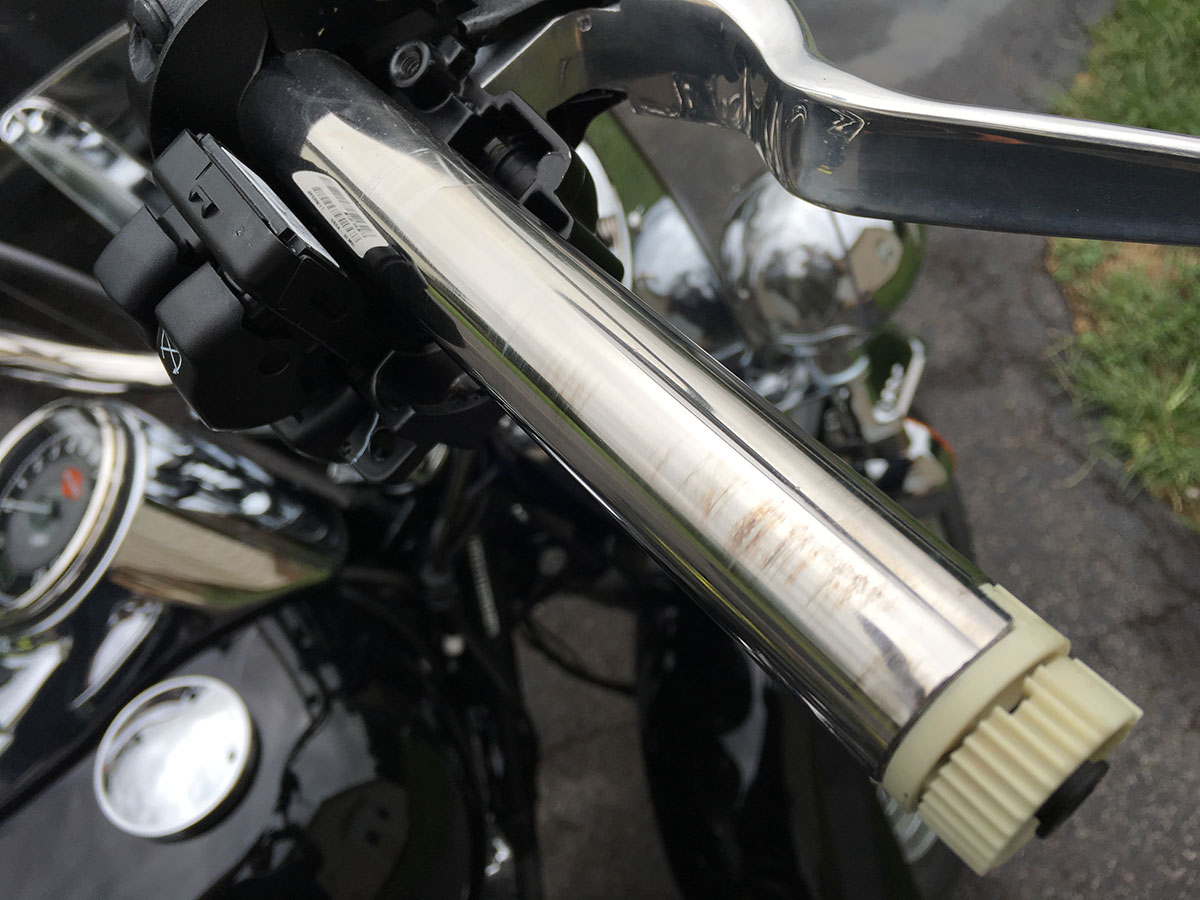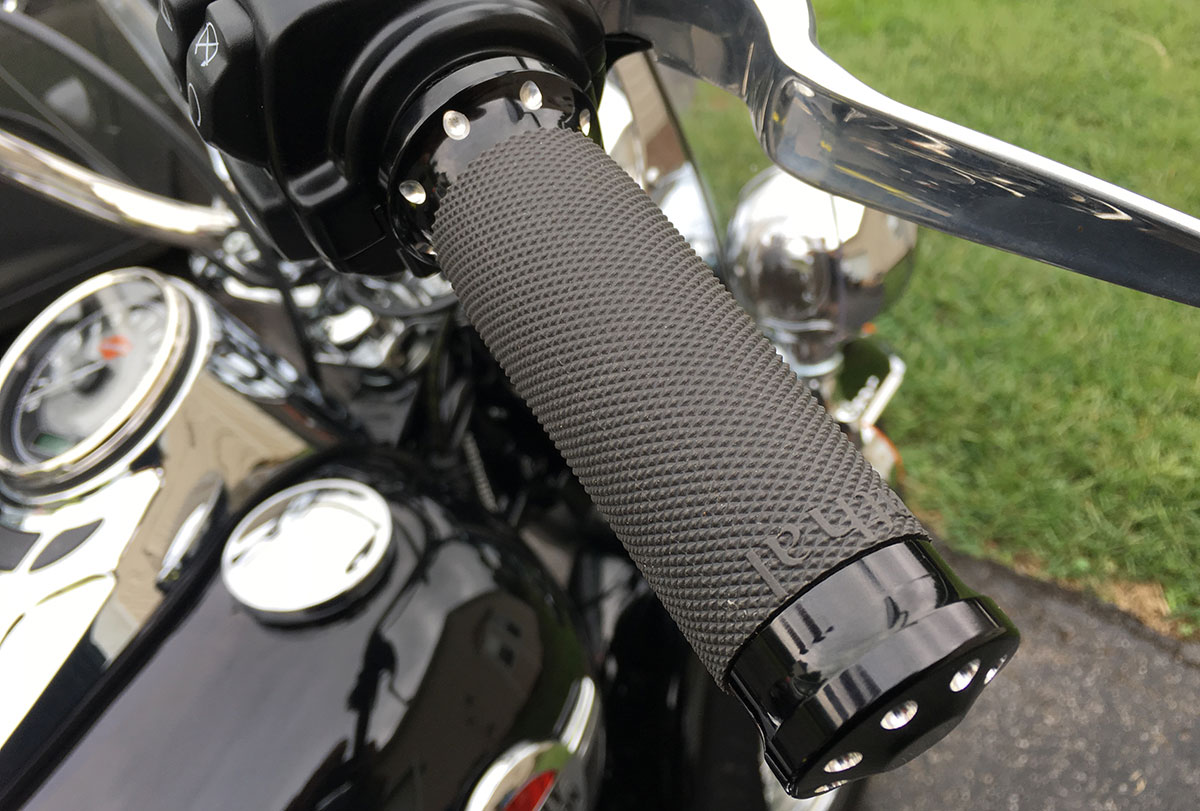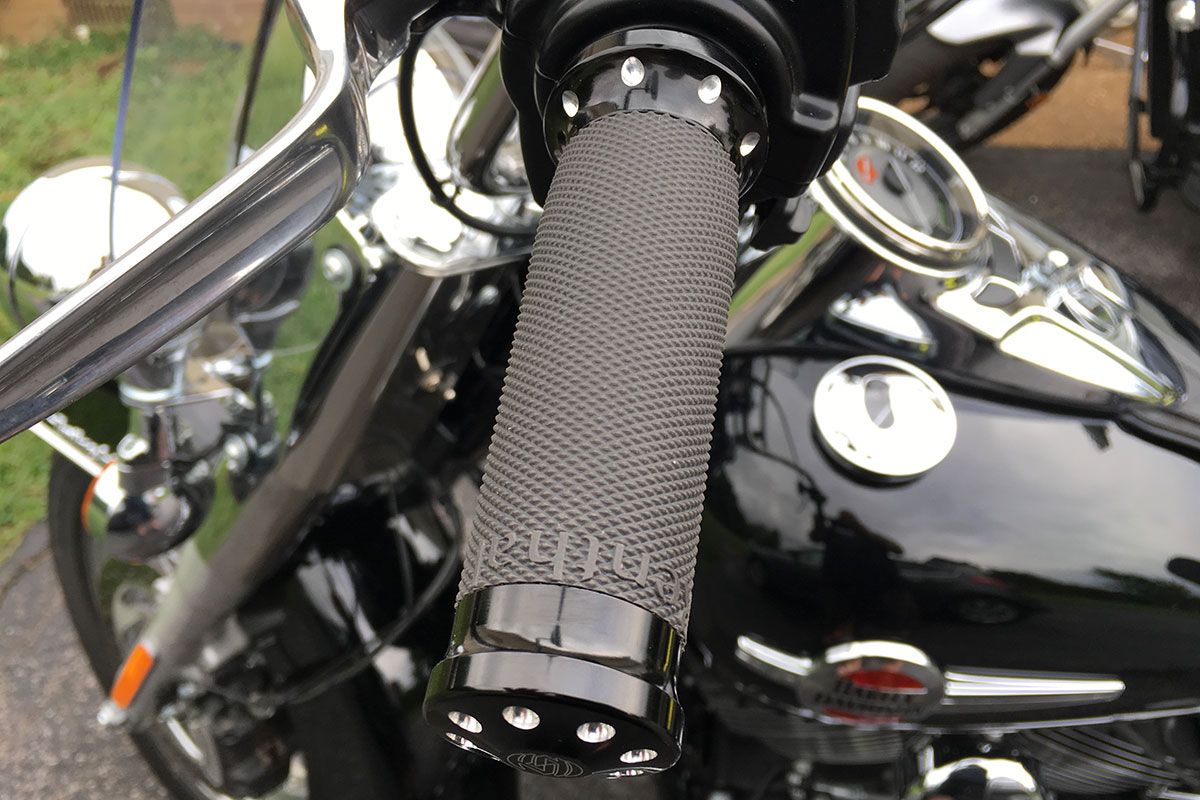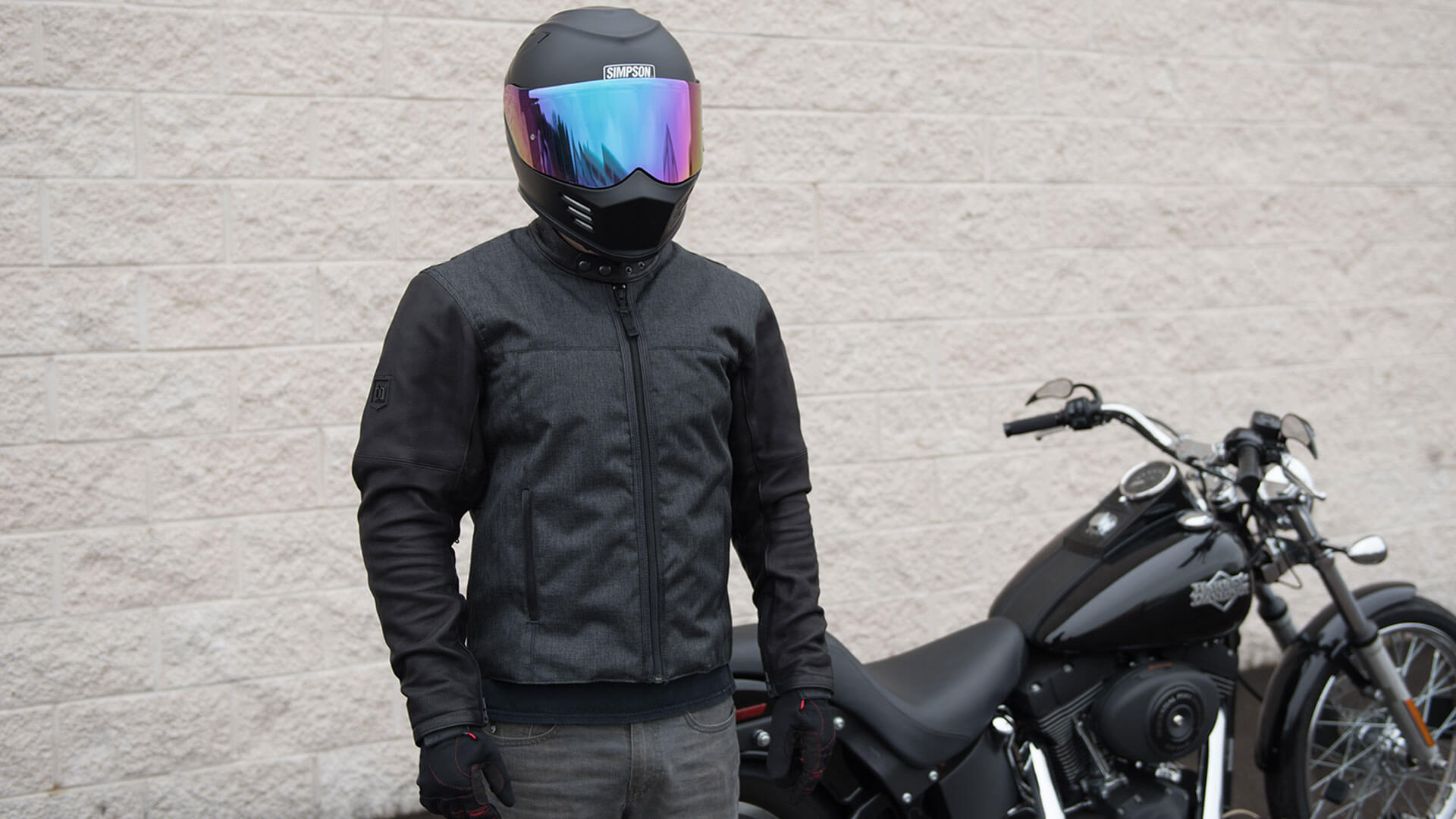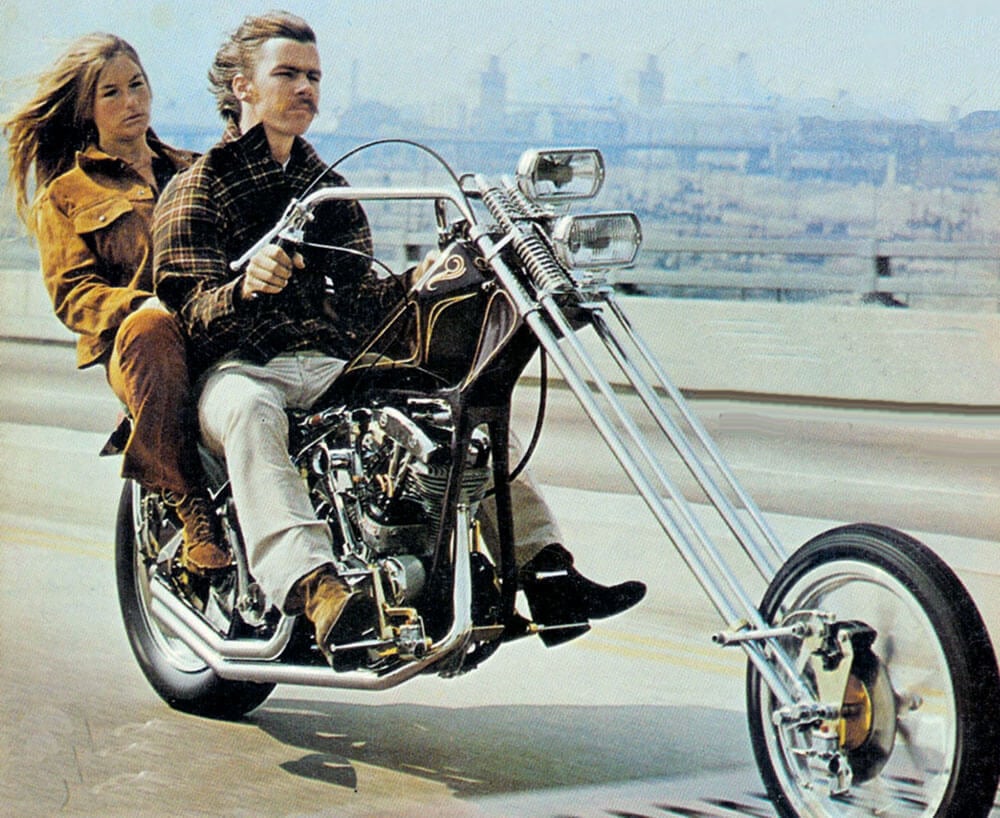
How to Replace Harley Grips: A DIY Guide
If you’re looking at changing out your Harley grips then you’re probably trying to solve one of two issues. Either your existing grips are causing you hand problems or you just don’t like the look of what’s currently on your bike. For me the story was a combination of both. The stock Harley-Davidson grips are terrible in both look and function, so I wanted an upgrade. For this project I chose the Roland Sands Designs Tracker Grips, and I’m really impressed with both the installation process and the end results.
Need new grips for your Harley? Shop our full selection of motorcycle grips now.
Removing Stock Harley Grips
- Loosen housing on throttle side
- Slide grip off from handlebar
- Loosen housing on clutch side
- Pry or cut grip off from handlebar
For most bikes, removing the stock grips is a pretty simple process. On the throttle side you’ll likely have a housing of some sort that you’ll need to remove and then the grip will slide right off. It’s possible, however, that you’ll have an application where there’s a tube inside the throttle grip that will need to be saved. If that’s the case, this can usually be done by splitting the grip with a sharp knife and then peeling it away from the tube. But for most aftermarket grips, you’ll find that they come with a replacement tube.
For my 2016 Harley-Davidson FLSTC, it was as simple as removing two torx screws in the housing, then sliding the grip off from the bar. The first screw sits in the top, toward the back of the housing. The second screw is under the housing and toward the front. Once those screws are removed, the top of the housing lifts right off. You’ll want to then carefully and lightly wiggle the bottom part of the housing to get it to move down. There’s wiring in here that you’ll want to protect, so just be gentle. Once both sides of the housing are removed, the throttle grip slides right off.
Moving to the clutch side, chances are that the grip only sits inside of the housing at the very end, but the housing probably doesn’t hold the grip in place. The grip is going to be secured by a glue, which means that you’ll have to do some work to get this one removed. The instructions provided with the Tracker grips say to use a long-shank, flat tip screwdriver to remove the grip, but I found that slicing the grip with a sharp knife and then peeling it off was a better option. Either way you choose, chances are that you’re going to ruin the grip so just be prepared to trash it instead of adding it to the “back to stock” box.
Installation of New Grips
Throttle Side
- Slide throttle grip or throttle tube into place
- If using a throttle tube, slide grip over tube
- Tighten housing
- Check to see that grip returns to neutral position
- If grip sticks, adjust housing tightness or slide grip out slightly
Clutch Side
- Slide clutch side grip into place
- Mark location for drilling divots
- Remove grip, drill divots
- If desired, apply grip adhesive to bar
- Slide grip into position, tighten placement screws
- Allow glue to dry according to directions
Depending on which grips you choose, your installation process could be slightly different. Specifically, some throttle side grips will have a two piece installation with a throttle tube and a grip that will need to be slid over it. Lucky for me, and perhaps because of the electronic throttle on the FLSTC, the Tracker throttle grip is a one piece design. All I had to do was make sure that the logo was in the right position and then slide the grip into place.
Or so I thought.
Come to find out, the Tracker grips are a bit longer than the stock H-D rubbers, so I had to do a bit of tweaking with the master cylinder housing. Loosening the two torx screws on the master cylinder housing, I was able to slide it in toward the middle about ¼ of an inch, allowing the grip to slide into place. With the grip in place, slide the lower housing back over the lip of the grip, then install the upper housing. Tighten the housing torx screws to stock torque specifications and you’re done with your throttle side.
As a side note: When installing your throttle grip, slide it into place and then tighten it down, but turn your throttle just slightly and release it. If the grip sticks, one of two things has happened. Either you’ve tightened the housing too much (your maintenance manual should give you torque specifications here) or you’ve actually pushed the grip too far onto the bar. The latter is what happened to me. I slid it into place, tightened everything down and then tested the throttle to find that it was sticking just slightly. This can be solved by sliding the grip out ever so slightly so that the gear is still engaging but the end of the grip isn’t dragging on the end of the bar.
For the clutch side, the motorcycle grip installation is a bit different. The grip is held in place by two screws that sit on the inside flare. You’ll want to position the grip, then mark the bar by using a tap through the two screw holes. I didn’t have a tap handy, so I used a thin drill bit to scratch the bar slightly. You’ll then slide the grip off and, using a drill, make a divot into the bar at both of your marked locations. What you’re aiming for is a slight depression where the screw will seat. Make sure to do this carefully so that you don’t drill completely through your bar.
With the divots drilled, slide the grip back into place and secure it with the two included screws, using a drop of medium duty thread locker such as Loctite. For those not installing these specific grips, or grips that are not secured by screws, you’ll want to use grip adhesive. Follow the label instructions and make sure to let it cure before riding.
Quick Tip: When sliding rubber grips into place, fill the grip with rubbing alcohol before attempting to put it onto the bar. The alcohol will act as a lubricant, but will evaporate quickly to let your adhesive cure.
You might find that you’ll have to move your clutch housing in order to get it to fit the grip placement. Just as you did on the throttle side, loosen your screws and slide the clutch housing into a position that allows it to sit next to the grip, or allows the inner lip of the grip to sit inside the housing if that is how your grips are designed.
Installing grips is a quick and easy project. With only a couple of tools required, most any rider should be able to knock out an install in an hour or less. The Tracker grips from Roland Sands Designs have been great for me. They have a slightly larger diameter than the stock grips, but not so much that I had to adjust any levers. The wider grip makes them more comfortable for me, and the Renthal rubber means that my hands never slip. I love the blacked out look that I chose, but there are a few different finishes to match any application.

